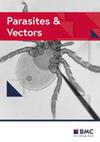多基因分析的启示:韩国济州岛上东南亚蚊子伊蚊(Mucidus)laniger(双翅目:库蚊科)的首次报告
IF 3
2区 医学
Q1 PARASITOLOGY
引用次数: 0
摘要
众所周知,某些蚊子是全球主要的传播媒介,传播传染病。由于气候变化和人类活动的增加,蚊子的栖息地扩大,促进了各种非本地传染病的传播,对健康构成了严重威胁。本研究重点是在大韩民国(韩国)最南端的济州岛上发现东南亚蚊子物种伊蚊(Mucidus)laniger(Wiedemann,1820 年),突出了与病媒传播疾病有关的潜在风险,特别强调了东南亚蚊子入侵的可能性增加。2023 年 8 月在济州岛进行了实地调查。使用 BG 哨兵诱捕器收集成蚊,并使用分类钥匙进行物种鉴定。采用形态学和分子分析确认物种名称。分子数据(包括线粒体和核基因)被用于系统发育分析,以比较和识别韩国记录的亚属。利用 R 软件包 "BIOMOD2 "对兰氏疟蚊进行物种分布建模,以预测潜在的栖息地。首次在济州岛采集到两只Ae.形态学和分子分析证实了该物种在 Mucidus 亚属中的身份,并验证了该物种在韩国的首次记录。我们采用简单的多基因系统发育分析,在属和亚属水平上确认了新的蚊子记录,最终验证了形态鉴定和分子系统发育结果之间的一致性。此外,我们还更新了韩国伊蚊属的分类钥匙,并修订了济州岛的蚊子名单,将兰氏伊蚊纳入其中。根据物种分布模型,兰尼格伊蚊的适宜栖息地面积预计将因气候变化而扩大,但这一变化在东亚似乎并无意义。本案例是韩国首次报告东南亚蚊子 Ae. laniger。在济州岛发现该物种表明,其栖息地有可能建立起一个繁殖种群,并引发了对其进一步向朝鲜半岛扩张的担忧。考虑到东南亚地区每年都会发生由蚊子传播的疾病病例,因此不仅要在济州岛(已发现兰尼格伊蚊),而且要在整个朝鲜半岛进行监测。本文章由计算机程序翻译,如有差异,请以英文原文为准。
Insights from multigene analysis: first report of a Southeast Asian Mosquito, Aedes (Mucidus) laniger (Diptera: Culicidae) on Jeju Island from Korea
Certain mosquitoes are known as dominant vectors worldwide, and transmit infectious diseases. The expansion of mosquito habitats due to climate change and increased human activities poses a significant health threat by facilitating the spread of various non-native infectious diseases. This study focused on the detection of the Southeast Asian mosquito species, Aedes (Mucidus) laniger (Wiedemann, 1820) on Jeju Island, the southernmost region of the Republic of Korea (ROK), highlighting the potential risks associated with the spread of vector-borne diseases, particularly emphasizing the elevated likelihood of invasion by Southeast Asian mosquitoes. Field surveys were conducted in August 2023 on Jeju Island. Adult mosquitoes were collected using BG-sentinel traps and identified to the species level using taxonomic keys. Morphological and molecular analyses were employed to confirm species designations. Molecular data, including mitochondrial and nuclear genes, were used for phylogenetic analysis, which was performed to compare and identify among recorded subgenera in ROK. Species distribution modeling for Ae. laniger was performed to predict potential habitats using R package ‘BIOMOD2’. The two specimens of Ae. laniger were collected for the first time on Jeju Island. Morphological and molecular analyses confirmed the identity of this species within the subgenus Mucidus and validated the first record of this species in the ROK. We employed a simple multigene phylogenetic analysis to confirm a new mosquito record at the genus and subgenus levels, finally validating the consistency between morphological identification and molecular phylogenetic outcomes. Furthermore, we have updated the taxonomic keys for the genus Aedes in the ROK, and revised mosquito lists for Jeju Island, incorporating the inclusion of Ae. laniger. On the basis of species distribution modeling, the area of suitable habitat for Ae. laniger is expected to expand due to climate change, but this change did not appear to be meaningful in East Asia. This case offers the first report of the Southeast Asian mosquito, Ae. laniger, in the ROK. The detection of this species on Jeju Island suggests the potential establishment of a breeding population their habitat and raises concerns about further expansion into the Korean Peninsula. Considering the annual occurrence of mosquito-borne disease cases in the Southeast Asia, it is essential to conduct monitoring not only in Jeju Island, where Ae. laniger has been identified, but also across the entire Korean Peninsula.
求助全文
通过发布文献求助,成功后即可免费获取论文全文。
去求助
来源期刊

Parasites & Vectors
医学-寄生虫学
CiteScore
6.30
自引率
9.40%
发文量
433
审稿时长
1.4 months
期刊介绍:
Parasites & Vectors is an open access, peer-reviewed online journal dealing with the biology of parasites, parasitic diseases, intermediate hosts, vectors and vector-borne pathogens. Manuscripts published in this journal will be available to all worldwide, with no barriers to access, immediately following acceptance. However, authors retain the copyright of their material and may use it, or distribute it, as they wish.
Manuscripts on all aspects of the basic and applied biology of parasites, intermediate hosts, vectors and vector-borne pathogens will be considered. In addition to the traditional and well-established areas of science in these fields, we also aim to provide a vehicle for publication of the rapidly developing resources and technology in parasite, intermediate host and vector genomics and their impacts on biological research. We are able to publish large datasets and extensive results, frequently associated with genomic and post-genomic technologies, which are not readily accommodated in traditional journals. Manuscripts addressing broader issues, for example economics, social sciences and global climate change in relation to parasites, vectors and disease control, are also welcomed.
 求助内容:
求助内容: 应助结果提醒方式:
应助结果提醒方式:


